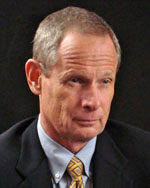
Paul Tash
Chairman, CEO and Editor, St. Petersburg Times
St. Petersburg, FL
[FL-E 0101]
I was at lunch with some reporters one day, and they said a funny thing happened today. A house caught fire out on one of the island communities, and it turns out it was owned by one of the ministers in town. And his wife set fire to it. And it wasn’t a parsonage – it wasn’t his permanent address – it was a house he owned just a few miles away from the official residence in a community where – in a part of town where he is basically unknown. This was the man who was the president of the National Baptist Convention, which described itself as the largest African-American church in America.
And it had been set fire by his wife because she discovered that – it was – he had a relationship with another woman, who was also an occasional resident of the house. And so we took an interest.
One story led to another, and it became clear that the Rev. Henry Lyons had significant private holdings, and had various relationships around the country. And [he] had concocted the story of the National Baptist Convention as being this huge organization, when in fact it was a fraction of the size he was describing. He had described it as being so many times larger as a way to con major corporations out of sponsorship fees, so that there would be more revenue coming into the church based on a larger audience rather than a smaller audience. And it was a con that even been featured on the front page of the – unwittingly featured on the front page of The New York Times – as a story about how this minister had been so sophisticated and had developed this big business success based upon the growth of his church, and how it had been such a strong source of revenue for it. And yet – with a match and some kerosene, one day – his wife, sort of, sparked our interest – if you will.
One thing led to another, and I was working – at the time – with some reporters for The St. Petersburg Times who I’m still enormously fond of, and every night I would go home, knowing what was going to be in the paper the next day because I was reading – the stakes were very high, it was a very sensitive story; there was initially some criticism of the paper by the minister that it was racially motivated, biased, prejudiced work – so I was very much involved in it.
And each night I would go home and think, “Oh, my God, I can’t believe that’s true, you know. Yes, I know it is – because we’ve checked, and we’re sure [of] the work. But how can that be true?”
And then one thing would just cascade to another, ultimately leading to the arrest, prosecution, and conviction of the pastor, and a prison sentence. And it was – and at the time I would have readers come up to me saying, “I can’t wait to go to my driveway to see what you’re going to have today.” Because one thing just built upon another.
It was the greatest fun I’ve ever had as an editor – and maybe as a journalist – to work on that kind of story with some thoroughbreds who were on it and to see the reaction and the engagement of the readership and then the official response to our story.
At one point a judge in the case asked the prosecutor, “I can’t really tell, Bernie, whether you’re following the reporters or whether the reporters are following you.”
And he said, “Oh, there’s no doubt. We’re following the reporters.”
And it was – it was one of those moments and one of those stories that you feel fortunate to have had a part of at any time in your career, and a little wistful that you know – you may not get another one like that again.


